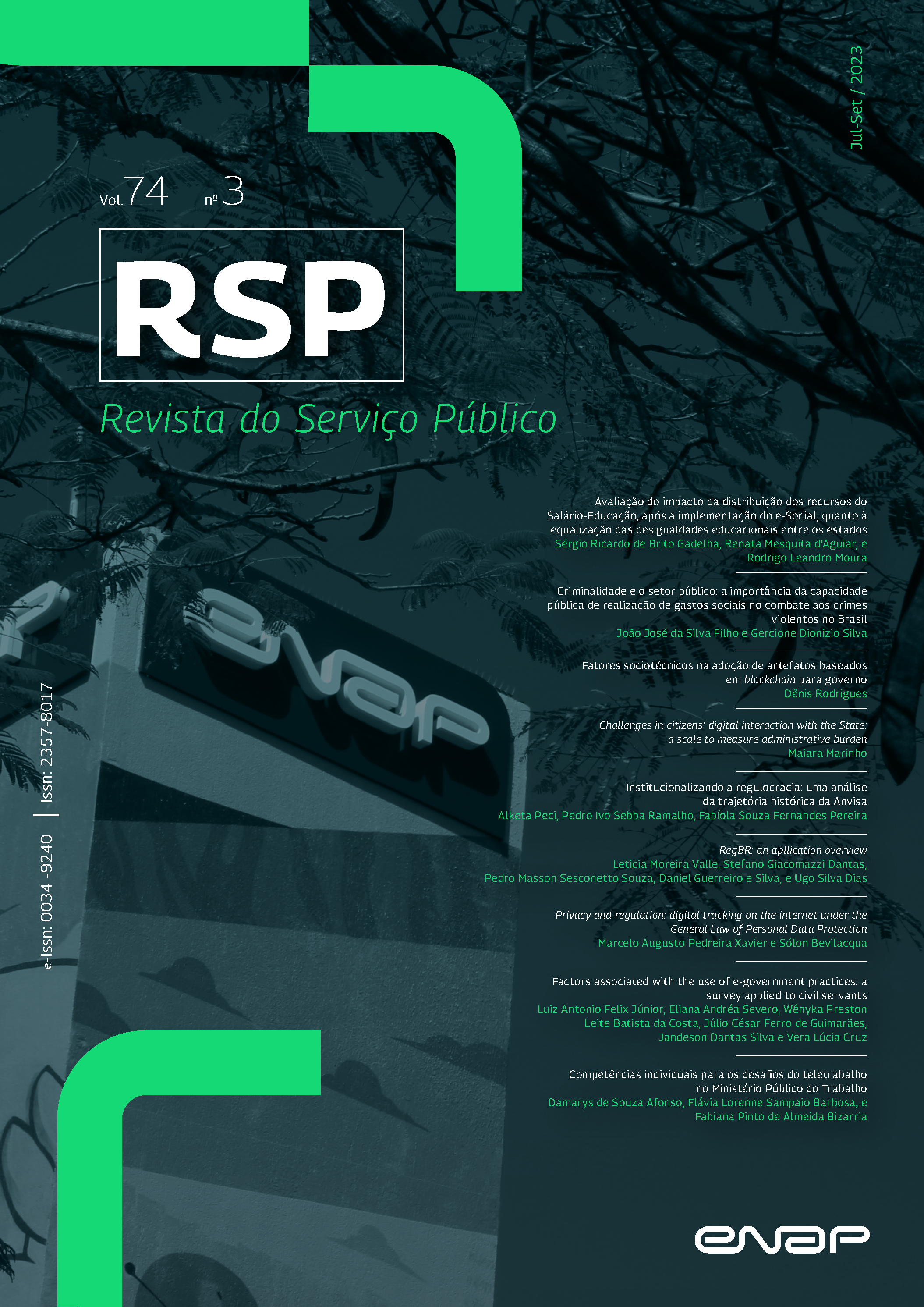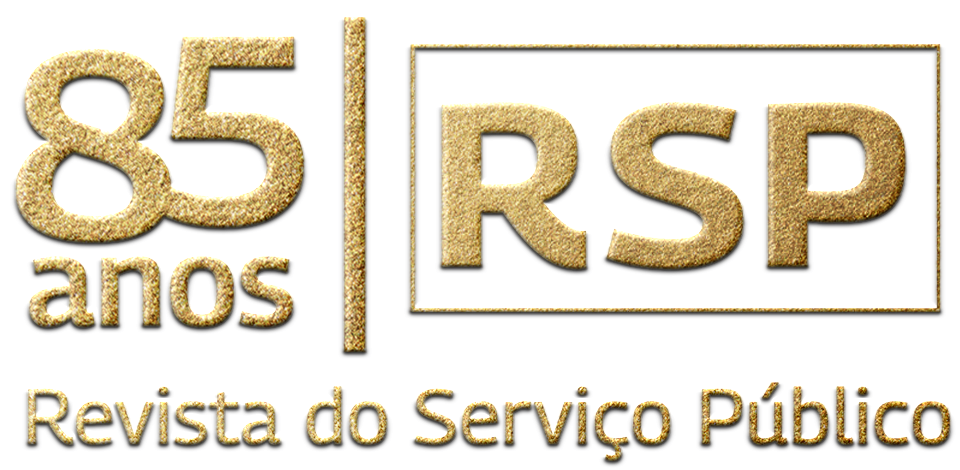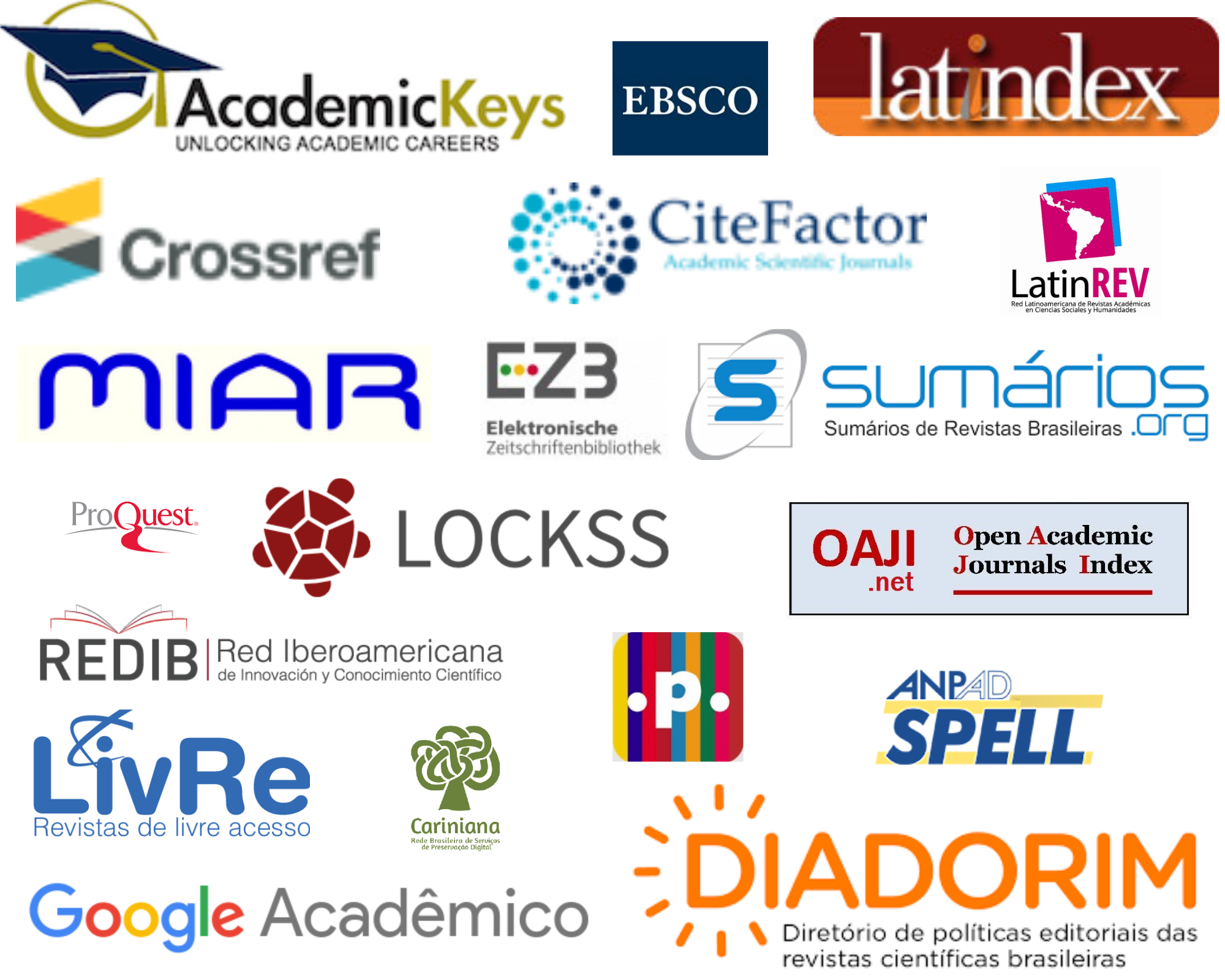Factors associated with the use of E-Government practices: a survey applied to civil servants
una encuesta aplicada a servidores públicos
Keywords:
e-government, civil servant, intent to useAbstract
This research aimed to verify the determining factors for using e-government practices from the perception of civil servants. We used a questionnaire with a five-point Likert scale to conduct the study. Data were analyzed using descriptive statistics, confirmatory factor analysis, and multiple linear regression, which evaluated five research hypotheses. The study sample included 206 federal and state civil servants from the Northeast region of Brazil. We confirmed that expectation of effort and performance, facilitating conditions, and social inclusion influence the intention to use e-government. At the same time, the hypothesis of innovative capacity was refuted, warning that servants do not need to have an entrepreneurial profile to adopt modern practices. Moreover, we found that the social influence factor is the one that has the most significant power of positive influence on the intent to use, demonstrating that the environment in which they live encourages the use of electronic practices.
Downloads
References
Abu-Shanab, E., & Shehabat, I. (2018). The influence of knowledge management practices on e-government success: A proposed framework tested. Transforming Government: People, Process and Policy, 12 (3/4), 286-308, 2018
Agarwal, U. A., Datta, S., Blake-Beard, S., & Bhargava, S. (2012). Linking LMX, innovative work behaviour and turnover intentions: The mediating role of work engagement. Career development international, 17(3), 208-230.
Ahn, M. J. (2011). Adoption of e-communication applications in US municipalities: The role of political environment, bureaucratic structure, and the nature of applications. The American Review of Public Administration, 41(4), 428-452.
Al-Rababah, B. A., & Abu-Shanab, E. A. (2010). E-government and gender digital divide: The case of Jordan. International Journal of Electronic Business Management, 8(1), 1-8.
Amanda, N. F. P. (2019). E-Government as Public Sector Innovation. Journal of Public Administration Studies, 4(2), In Press.
Baptista, M. V. (2000). Planejamento social: intencionalidade e instrumentação. Ed. 2, Veras, São Paulo.
Bhatia, K. (2020). E-Government and E - Governance: issues and Challenges. Our Heritage, 68(9), 800–808.
Batara, E., Nurmandi, A., Warsito, T., & Pribadi, U. (2017). Are government employees adopting local e-government transformation? The need for having the right attitude, facilitating conditions and performance expectations. Transforming Government: People, Process and Policy, 11 (4), 612-638.
Ben, E. R., & Schuppan, T. (2014). E-Government Innovations and Work Transformations: Implications of the introduction of electronic tools in public government organizations. International Journal of Electronic Government Research (IJEGR), 10(1), 1-17.
Budiati, A. (2018). E-Government and E-Governance: can its improve indonesian public service deliveries?. Iapa Proceedings Conference, [S.l.], 392-404. Recuperado em 17 março, 2020, de https://journal.iapa.or.id/proceedings/article/view/212
Costa, F. J. (2011). Mensuração e desenvolvimento de escalas. Editora Ciência Moderna Ltda, Rio de Janeiro.
Curristine, T., Lonti, Z., & Joumard, I. (2007). Improving public sector efficiency: Challenges and opportunities. OECD Journal on Budgeting, 7(1), 161.
De Guimarães, J. C. F., Severo, E. A., Felix Júnior, L. A., Da Costa, W. P. L. B., & Salmoria, F. T. (2020). Governance and quality of life in smart cities: Towards sustainable development goals. Journal of Cleaner Production, 253, 119926.
De Guimarães, J. C. F., Severo, E. A., & de Vasconcelos, C. R. M. (2018). The influence of entrepreneurial, market, knowledge management orientations on cleaner production and the sustainable competitive advantage. Journal of cleaner production, 174, 1653-1663.
Domínguez, L. R., Sánchez, I. M. G., & Álvarez, I.G (2011). Determining factors of e-government development: A worldwide national approach. International Public Management Journal, 14(2), 218-248.
Downing, J. C. D. (2011). Estatística aplicada. Editora Saraiva.
European Parliament. (2014). Mapping smart cities in the EU. Brussels, Belgium: European Parliament, Directorate General for internal policies. Recuperado de europarl.europa.eu/RegData/etudes/etudes/join/2014/507480/IPOLITRE_ET(2014)507480_EN.pdf
Freitas, H., Oliveira, M., Saccol, A. Z., & Moscarola, J. (2000). O método de pesquisa survey. Revista de Administração da USP, 35(3), 105-112.
Gaikwad, N. N. (2020). M-Governance in India: Problems and Strategies. Our Heritage, 68(9), 1136 – 1140.
Gil-García, J. R., & Pardo, T. A. (2005). E-government success factors: Mapping practical tools to theoretical foundations. Government information quarterly, 22(2), 187-216.
Hair, J. F., Black, W. C., Babin, B. J., & Anderson, R. E. (2010). Multivariate data analysis: Pearson new international edition. Pearson Higher Ed.
Hartley, J. (2013). Public and private features of innovation. Handbook of innovation in public services, 44-59.
Hsu, M., Hou, S., & Fan, H. (2011). Creative self‐efficacy and innovative behavior in a service setting: Optimism as a moderator. The Journal of Creative Behavior, 45(4), 258-272.
Im, T., Cho, W., Porumbescu, G., & Park, J. (2012). Internet, trust in government, and citizen compliance. Journal of Public Administration Research and Theory, 24(3), 741-763.
Janowski, T., Pardo, T. A., & Davies, J. (2012). Government information networks-mapping electronic governance cases through public administration concepts. Government Information Quarterly, 29(1), S1-S10.
Janssen, O. (2000). Job demands, perceptions of effort-reward fairness and innovative work behaviour. Journal of Occupational and Organizational Psychology, 73(3), 287–302.
Janssen, M., Rana, N. P., Slade, E. L., & Dwivedi, Y. K. (2018). Trustworthiness of digital government services: deriving a comprehensive theory through interpretive structural modelling. Public Management Review, 20(5), 647-671.
Jun, K. N., & Weare, C. (2010). Institutional motivations in the adoption of innovations: The case of e-government. Journal of Public Administration Research and Theory, 21(3), 495-519.
Kumar, R., Sachan, A., & Mukherjee, A. (2017). Qualitative approach to determine user experience of e-government services. Computers in Human Behavior, 71, 299-306.
Lam, W. (2005). Barriers to e-government integration. Journal of Enterprise Information Management, 18(5), 511-530.
Leonnel, A. C. M., Tonelli, D. F., Leme, P. H. M. V., & Amâncio, J. M. (2018). Limites e Possibilidades da Interação Sociopolítica entre Sociedade e Câmara dos Deputados pelo Portal Eletrônico e-Democraciai. Administração Pública e Gestão Social, 10(3), 212-221.
Liu, S. M., & Yuan, Q. (2015). The evolution of information and communication technology in public administration. Public Administration and Development, 35(2), 140-151.
Manoharan, A. P., Ingrams, A., Kang, Dongyoen, & Zhao, H. (2020). Globalization and Worldwide Best Practices in E-Government, International Journal of Public Administration, 1 –12, In Press. Doi: 10.1080/01900692.2020.1729182
Manoharan, A. P., & Ingrams, A. (2018). Conceptualizing e-government from local government perspectives. State and Local Government Review, 50(1), 56-66.
Marôco, J. (2010). Análise de equações estruturais: Fundamentos teóricos, software & aplicações. ReportNumber, Lda.
Mazzucato, M. (2013). The entrepreneurial state: Debunking public vs. private sector myths (Vol. 1). Anthem Press.
Meijer, A., & Bolívar, M. P. R. (2016). Governing the smart city: a review of the literature on smart urban governance. International Review of Administrative Sciences, 82(2), 392-408.
Morgan, J. Q. (2010). Governance, policy innovation, and local economic development in North Carolina. Policy Studies Journal, 38(4), 679-702.
Norris, D. F., & Reddick, C. G. (2013). Local e‐government in the United States: Transformation or incremental change?. Public Administration Review, 73(1), 165-175.
Nulhusna, R., Sandhyaduhita, P. I., Hidayanto, A. N., & Phusavat, K. (2017). The relation of e-government quality on public trust and its impact on public participation. Transforming Government: People, Process and Policy, 11(3), 393-418.
Paese, C., Caten, C., & Ribeiro, J. L. D. (2001). Aplicação da análise de variância na implantação do CEP. Revista Produção, 11(1), 17-26.
Park, S., & Jo, S. J. (2018). The impact of proactivity, leader-member exchange, and climate for innovation on innovative behavior in the Korean government sector. Leadership & Organization Development Journal, 39(1), 130-149.
Pereira, V. P., Martins, V. F., & Maia, L. C. C. (2011). O Papel das Âncoras na Aceitação da Tecnologia da Informação: Um Estudo de Caso da Substituição de um Sistema de Informação Gerencial. Anais do XXXV Encontro do Anpad - ENANPAD, Rio de Janeiro, RJ, Brasil, 35.
Poonam, Verma, P., & Vats, S. K. (2020). Role of Ict in E-Governance and Rural Development in India. Studies in Indian Place Names (UGC Care Journal), 40 (3), 3610– 3620.
Potnis, D. D. (2010). Measuring e-Governance as an innovation in the public sector. Government Information Quarterly, 27(1), 41-48.
Ramírez-Alujas, A. (2016). Laboratorios de gobierno como plataformas para la innovación pública. In G.M. Cejudo, M.I.D. Laguna, & C. Michel (Orgs.). La innovación en el sector público: Tendencias internacionales y experiencias mexicanas, 163-203. Ciudad de México: Instituto Nacional de Administración Pública.
Rana, N. P., Dwivedi, Y. K., Williams, M. D., & Weerakkody, V. (2015). Investigating success of an e-government initiative: Validation of an integrated IS success model. Information Systems Frontiers, 17(1), 127-142.
Rey-Moreno, M., Felício, J. A., Medina-Molina, C., & Rufín, R. (2018). Facilitator and inhibitor factors: Adopting e-government in a dual model. Journal of Business Research, 88, 542-549.
Severo, E. A., De Guimarães, J. C. F., & Dorion, E. C. H. (2018). Cleaner production, social responsibility and eco-innovation: Generations' perception for a sustainable future. Journal of Cleaner Production, 186, 91-103.
Shim, D. C., & Eom, T. H. (2008). E-government and anti-corruption: Empirical analysis of international data. Intl Journal of Public Administration, 31(3), 298-316.
Setiawan, A. I., Nguyen, P. T., Perumal, E., Shankar, K., Abadi, S., Hashim, W., & Maseleno, A. (2019). Village’s E-Government Ade Irfan Setiawan. International Journal of Engineering and Advanced Technology, 8 (6S2), 1026–1029.
Thurlings, M., Evers, A. T., & Vermeulen, M. (2015). Toward a model of explaining teachers’ innovative behavior: a literature review. Review of Educational Research, 85(3), 430-471.
Venkatesh, V., Morris, M. G., Davis, G. B., & Davis, F. D. (2003). User acceptance of information technology: Toward a unified view. MIS quarterly, 27(3), 425-478.
Wang, S., & Feeney, M. K. (2016). Determinants of information and communication technology adoption in municipalities. The America Review of Public Administration, 46, 292–313.
Wooldridge, J. M. (2006). Introductory econometrics: a modern approach, 3rd. New York: Thomson.
Wong, C. H., Tan, G. W. H., Tan, B. I., & Ooi, K. B. (2015). Mobile advertising: the changing landscape of the advertising industry. Telematics and Informatics, 32(4), 720-734.
Yuan, F., & Woodman, R. W. (2010). Innovative behavior in the workplace: the role of performance and image outcome expectations. Academy of management journal, 53(2), 323-342.
Downloads
Published
How to Cite
Issue
Section
License
Copyright (c) 2023 Revista do Serviço Público

This work is licensed under a Creative Commons Attribution-NonCommercial-ShareAlike 4.0 International License.
- A RSP adota a licença Creative Commons (CC) do tipo Atribuição – Uso Não-Comercial (BY-NC).
- A licença permite que outros remixem, adaptem e criem obra licenciada, sendo proibido o uso com fins comerciais.
- As novas obras devem fazer referência ao autor nos créditos e não podem ser usadas com fins comerciais, porém não precisam ser licenciadas sob os mesmos termos dessa licença.
- Ao publicar o artigo na RSP, o autor cede e transfere para a ENAP os direitos autorais patrimoniais referentes ao artigo.
- O artigo publicado na RSP não poderá ser divulgado em outro meio sem a devida referência à publicação de origem.
- O autor que tiver o artigo publicado na RSP deverá assinar o Termo de Concessão de Direitos Autorais (em momento oportuno a editoria da Revista entrará em contato com o autor para assinatura do Termo).



